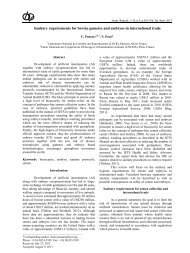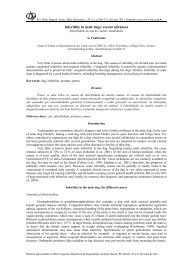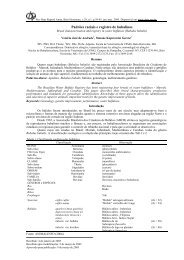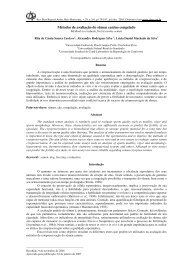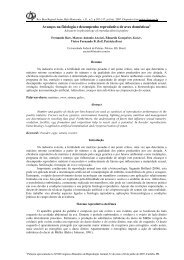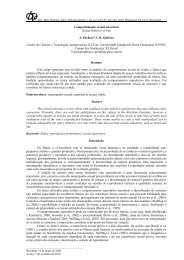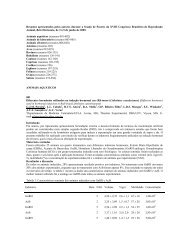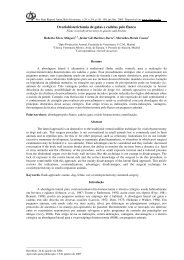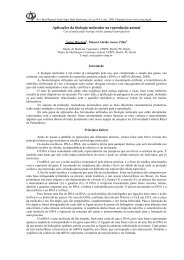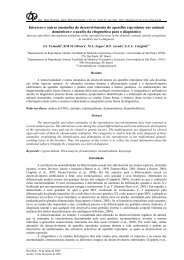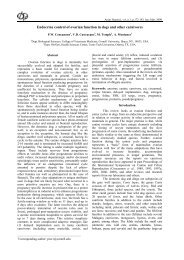Recent advances in ovulation synchronization and superovulation in ...
Recent advances in ovulation synchronization and superovulation in ...
Recent advances in ovulation synchronization and superovulation in ...
Create successful ePaper yourself
Turn your PDF publications into a flip-book with our unique Google optimized e-Paper software.
Abstracts. II International Symposium on Animal Biology of Reproduction, Nov. 19-22, 2008, São Paulo, SP, Brazil.<br />
Hypoxia, glucose uptake <strong>and</strong> vascularization <strong>in</strong> CL of non-pregnant dogs<br />
L.M.M.C. Sousa 1 , V.C. Amaral 1 , J. Burat<strong>in</strong>i Jr 2 , B. Hoffmann 3 , P.C. Papa 1<br />
1 Sector of Anatomy, Dept. of Surgery, FMVZ/USP, SP, Brazil, 05508-270.<br />
2 Dept. of Physiology, IB/UNESP, Botucatu, SP, Brazil.<br />
3 Kl<strong>in</strong>ik fuer Geburtshilfe, Gynaekologie und Andrologie der Gross- und Kle<strong>in</strong>etiere mit tierarztlicher Ambulanz, Justus-Liebig-<br />
Universität Gieβen, Gieβen, Germany.<br />
Introduction<br />
Luteolysis <strong>in</strong> dogs, differently from farm animals, occurs <strong>in</strong>dependently of a uter<strong>in</strong>e luteolys<strong>in</strong> (1). Dur<strong>in</strong>g can<strong>in</strong>e<br />
functional luteolysis, a decrease <strong>in</strong> progesterone (P4) concentrations occurs after day 20 after <strong>ovulation</strong> (Day 0 =<br />
<strong>ovulation</strong>). Morphological features of luteal <strong>and</strong> endothelial cells degeneration are first observed after day 45 after<br />
<strong>ovulation</strong>, concomitantly with a decrease <strong>in</strong> blood oxygen content <strong>in</strong> luteal tissue, which arises to hypoxic levels.<br />
Whether hypoxia plays a role <strong>in</strong> the regulation of corpus luteum (CL) function <strong>in</strong> the bitch is not clear. Angiogenesis<br />
<strong>and</strong> glycolysis are regulated by hypoxia through specific transcriptional factors up-regulation, notably hypoxia<br />
<strong>in</strong>ducible factor-1α (HIF-1α, 2). Thus, we hypothesized that HIF-1α is <strong>in</strong>volved <strong>in</strong> angiogenesis <strong>and</strong> glucose<br />
availability <strong>in</strong> different functional phases of can<strong>in</strong>e ovarian cycle, especially dur<strong>in</strong>g diestrus, contribut<strong>in</strong>g to local<br />
regulation of CL function.<br />
Materials <strong>and</strong> Methods<br />
For that purpose, we assessed mRNA levels of HIF-1α, Facilitative Glucose Transporter 1 (GLUT1), vascular<br />
endothelial growth factor (VEGF) <strong>and</strong> VEGF receptors - Flt-1 <strong>and</strong> KDR. Crossbred adult female dogs were<br />
submitted to ovarysalp<strong>in</strong>gohysterectomy each ten days from day 10 to 70 after <strong>ovulation</strong> (n = 4/group). Blood<br />
samples were collected to P4 assessment by RIA. The day of <strong>ovulation</strong> was considered the day when plasma P4<br />
levels reached ≥5ng/ml (3). CL were dissected <strong>and</strong> stored at – 80ºC until RNA was extracted, reversed transcribed<br />
<strong>and</strong> cDNA submitted to Real time (TaqMan) RT-PCR analysis. GAPDH was used as housekeep<strong>in</strong>g gene. Statistical<br />
analysis was done us<strong>in</strong>g One-way analysis of variance followed by Newman-Keuls test. Correlations were done<br />
us<strong>in</strong>g Spearman’s correlation test. Differences were considered significant when p ≤ 0.05.<br />
Results <strong>and</strong> Discussion<br />
P4 concentration was peaked at day 20 after <strong>ovulation</strong> (22.95 ± 3.84 ng/mL), <strong>and</strong> decreased cont<strong>in</strong>uously<br />
towards day 70 (0.67 ± 0.51 ng/mL). HIF-1α <strong>and</strong> GLUT1 mRNA expression was differentially regulated over<br />
diestrus show<strong>in</strong>g a concomitant down regulation at day 40 after <strong>ovulation</strong>. <strong>and</strong> were positively correlated to<br />
each other (r = 0.523, p = 0.01). VEGF, Flt-1 <strong>and</strong> KDR mRNA expression was also cycle dependent <strong>and</strong> higher<br />
dur<strong>in</strong>g the early <strong>and</strong> mid than <strong>in</strong> the late luteal phase. Although VEGF expression was highly positively correlated to<br />
VEGFRs expression (r ≥ 0.62, p ≤ 0.007), nor VEGF either VEGFRs showed any correlation to HIF-1α <strong>and</strong><br />
GLUT1. P4 concentrations were correlated to VEGF <strong>and</strong> VEGFRs expression (r = 0.65, p < 0.05), however, nor<br />
HIF-1α either GLUT1 showed any correlation to P4. These f<strong>in</strong>d<strong>in</strong>gs suggest that HIF-1α acts directly stimulat<strong>in</strong>g<br />
GLUT-1 mRNA expression, apparently <strong>in</strong>dependent of P4 production. Humoral factors, as P4, may be <strong>in</strong>volved <strong>in</strong><br />
angiogenic process regulat<strong>in</strong>g VEGF expression (4) or vice-versa (5). Thus, our data po<strong>in</strong>t towards direct<br />
<strong>in</strong>volvement of angiogenic factors <strong>in</strong> CL formation, lifespan <strong>and</strong> function. Additionally, our results provide evidence<br />
for the role of HIF-1α <strong>in</strong> glucose uptake by CL, suggest<strong>in</strong>g that HIF-1α time-dependent expression is essential for<br />
luteal cells function ma<strong>in</strong>tenance under hypoxic stress.<br />
References<br />
(1) Hoffmann B, Hoveler R, et al. 1992. J Reprod Fertil, 96:837-845; (2) Nilsson I, Shibuya M, et al. 2004. Exp Cell<br />
Res, 299:476-485; (3) Concannon PW, McCann JP, et al. 1989. J Reprod Fertil, 39:3-25. (4) Mayb<strong>in</strong> JA, Duncan<br />
WC. 2004. Reproduction, 128:423-431; (5) Yamashita H, Kamada D, et al. 2008. Mol Reprod Dev, DOI<br />
10/102/mrd.<br />
F<strong>in</strong>ancial support: CNPq<br />
E-mail: ppapa@usp.br<br />
Anim. Reprod., v.6, n.1, p.233, Jan./Mar. 2009 233



